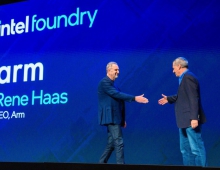IBM and ARM to Collaborate on 14nm Semiconductor Technology for Mobile Electronics
ARM and IBM today announced an agreement between the two companies to extend their collaboration on advanced semiconductor technologies to enable the rapid development of next generation mobile products optimized for performance and power efficiency.
The resulting technology will provide a suite of optimized physical and processor IP by ARM tuned to IBM's advance manufacturing process down to 14nm.
As the consumer's requirements increase for high end features on mobile devices including; extended battery life, uninterrupted internet access, high end multimedia and secure transactions the chip design becomes increasingly more challenging. Designers must consider nanometer scale effects in terms of lithography, variability, and so on while simultaneously meeting performance, power and area (PPA) targets across hundreds of millions of transistors. This increased complexity potentially results in additional in-house design time.
Through this agreement ARM and IBM will collaboratively develop design platforms aligning the manufacturing process, microprocessor and physical IP design teams. This collaboration will minimize the risk and barriers to migrating to smaller geometries while enabling optimized density, performance, power and yield in advanced SoC designs; accelerating the introduction of advanced electronics into the marketplace.
"ARM's Cortex processors have become the leadership platform for the majority of smart phones and many other emerging mobile devices," said Michael Cadigan, general manager, IBM Microelectronics. "We plan to continue working closely with ARM and our foundry customers to speed the momentum of ARM technology by delivering highly advanced, low-power semiconductor technology for a variety of new communications and computing devices"
"IBM has a proven track record of delivering the core research and development that is relied upon by major semiconductor vendors worldwide for their advanced semiconductor devices. Their leadership of the ISDA alliance, which features a diverse set of top-tier companies as members, is growing in importance as consolidation trends in the semiconductor manufacturing industry continue" said Simon Segars, EVP and general manager, ARM physical IP division. "This agreement will ensure we are able to deliver highly tuned ARM Artisan Physical IP solutions on advanced ISDA process technologies to meet the early time-to-market our customers demand."
Past collaboration with IBM and ARM on advanced geometries have been underway since 2008, resulting in the implementation of extensive process and physical IP refinements to improve SoC density, routability, manufacturability, power consumption, and performance. Moreover, through the previous collaboration on the 32nm and 28nm ARM has already delivered eleven test chips that provide concrete research structures and early silicon validation. In addition, ARM has developed specific optimizations targeting ARM processor cores including most recently a complete ARM Cortex-A9 processor core implemented on 32nm High-K Metal Gate technology.
As the consumer's requirements increase for high end features on mobile devices including; extended battery life, uninterrupted internet access, high end multimedia and secure transactions the chip design becomes increasingly more challenging. Designers must consider nanometer scale effects in terms of lithography, variability, and so on while simultaneously meeting performance, power and area (PPA) targets across hundreds of millions of transistors. This increased complexity potentially results in additional in-house design time.
Through this agreement ARM and IBM will collaboratively develop design platforms aligning the manufacturing process, microprocessor and physical IP design teams. This collaboration will minimize the risk and barriers to migrating to smaller geometries while enabling optimized density, performance, power and yield in advanced SoC designs; accelerating the introduction of advanced electronics into the marketplace.
"ARM's Cortex processors have become the leadership platform for the majority of smart phones and many other emerging mobile devices," said Michael Cadigan, general manager, IBM Microelectronics. "We plan to continue working closely with ARM and our foundry customers to speed the momentum of ARM technology by delivering highly advanced, low-power semiconductor technology for a variety of new communications and computing devices"
"IBM has a proven track record of delivering the core research and development that is relied upon by major semiconductor vendors worldwide for their advanced semiconductor devices. Their leadership of the ISDA alliance, which features a diverse set of top-tier companies as members, is growing in importance as consolidation trends in the semiconductor manufacturing industry continue" said Simon Segars, EVP and general manager, ARM physical IP division. "This agreement will ensure we are able to deliver highly tuned ARM Artisan Physical IP solutions on advanced ISDA process technologies to meet the early time-to-market our customers demand."
Past collaboration with IBM and ARM on advanced geometries have been underway since 2008, resulting in the implementation of extensive process and physical IP refinements to improve SoC density, routability, manufacturability, power consumption, and performance. Moreover, through the previous collaboration on the 32nm and 28nm ARM has already delivered eleven test chips that provide concrete research structures and early silicon validation. In addition, ARM has developed specific optimizations targeting ARM processor cores including most recently a complete ARM Cortex-A9 processor core implemented on 32nm High-K Metal Gate technology.





















